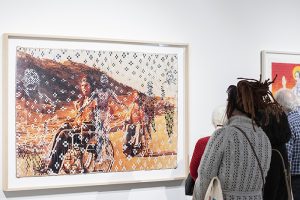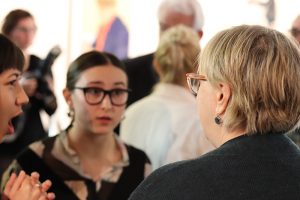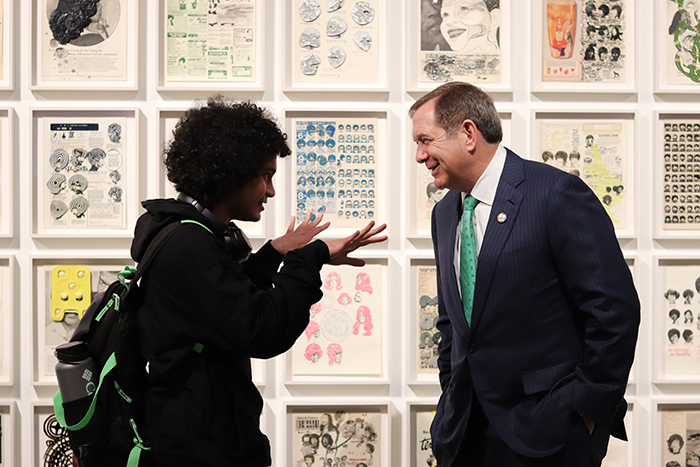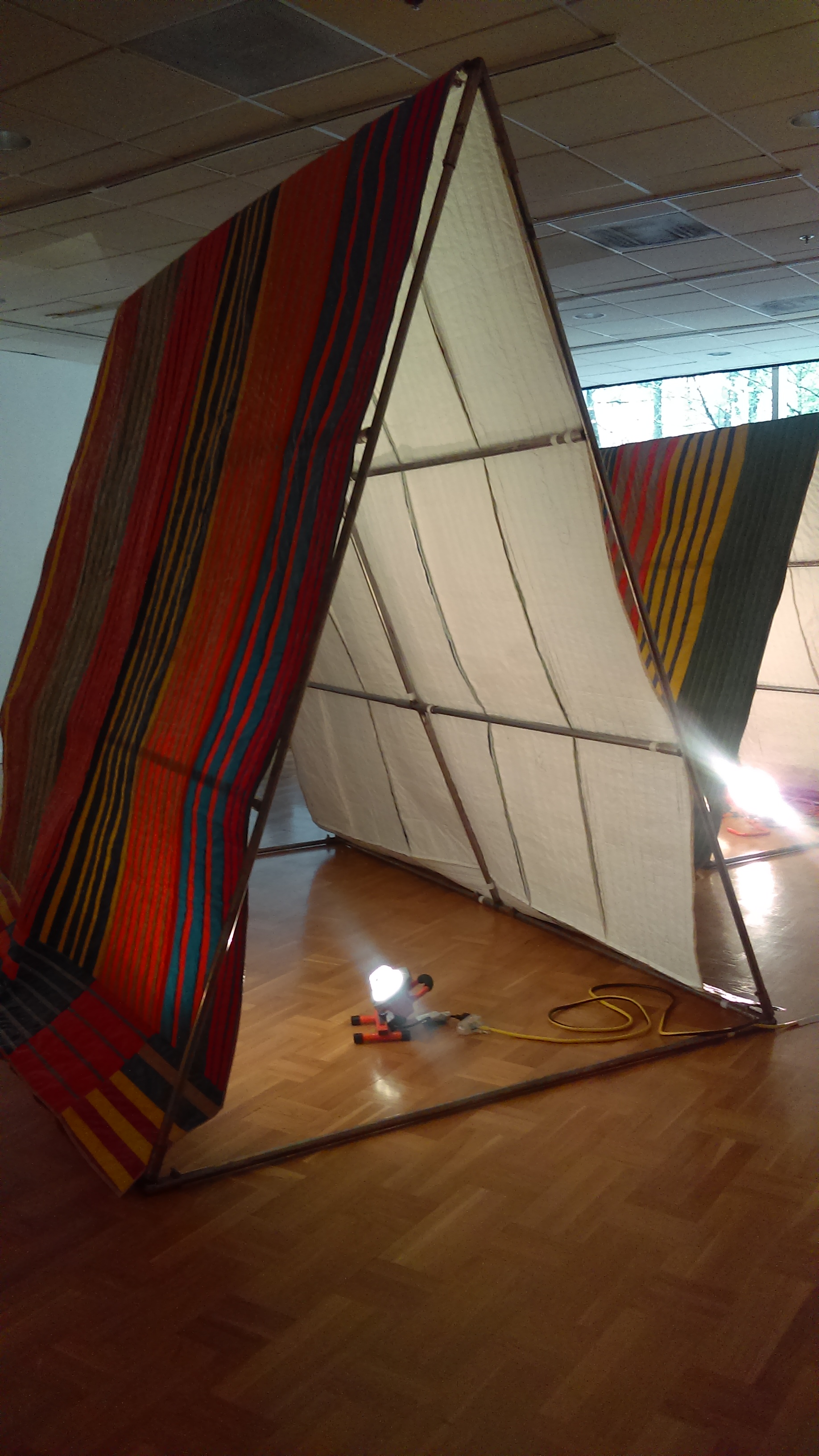The opening ceremony for the Jordan Schnitzer Museum of Art (JSMA) featured a real who’s who crowd of not only Portland’s art institutional world, but also Portland State University bureaucracy, and Portland. A packed crowd literally squeezed into the museum on November 7, 2019 for a grand opening ceremony at 10a.m. There have only been a handful of events where it seemed Portland’s art world collectively decided an event was important. The closing reception featuring the destruction of iconic photographer Robert Frank’s exhibition at Blue Sky was one of those times. Institute of Contemporary Art, Los Angeles and New Museum Triennial curator and writer Jamillah James’s lecture was another. The latest was the opening of the Jordan Schnitzer Museum of Art.
The opening exhibition, Art for All featured selections from Schnitzer’s massive art collection. For free, anyone can enter and experience some of the greatest contemporary artists of all of our lifetimes: from Jean-Michel Basquiat to Kiki Smith, Kara Walker to David Hockney, to Kerry James Marshall, Ellen Gallagher, Anish Kapoor, and Jeff Koons.
After a slightly delayed start, Director of the Indigenous Nations Studies and Interim Director of the School of Gender, Race, and Nations Theodore Van Alst, Jr. presented a land acknowledgement, but proposed a twist.
“The Kalapuyans, Clackamas, and Molallas in Willamette Valley were forcibly removed during the winter of 1855 to 1856,” Van Alst said. “…Many of those people said they’d rather die than leave their homelands. That, I want you to understand, is the value of the land that we’re all currently standing on.
“Thus, we have an obligation to recognize our privilege and our responsibility to the land, to our relative that supports us every day in so many ways. The Lakota word for grandmother is Unci, a dear and respected relative. And the word for this planet is Unci Maka, Grandmother Earth.”
After he finished, Van Alst added: “And we’re here to celebrate art. I’m really jazzed.”
As attendees filed in for the grand opening. Therman Statom had literally just put the final touches on a massive glass wall art installation commissioned by Schnitzer, some tools and a caulk gun were still on a table nearby.
After Schnitzer and his daughter cut JSMA’s ceremonial ribbon with a comically large pair of scissors, a flash mob of students started singing and jumping around the museum while someone played djembe.
The flash mob turned out to be the PSU Chamber Choir singing Haitian Vodou song “Papa Loko” arranged by Sten Kallman. Ethan Sperry, Director of Choral Activities, was waving his arms around, conducting the performance from atop the museum’s welcome desk next to JSMA’s Marketing and Communications Manager Emily Stennes.
Stennes has been the events coordinator for University Communications and the PSU President’s office. Stennes’s background in museum studies prepared her for her current role as part of the museum’s start up team and spoke about the institution’s vision.
Stennes was excited Linda Tesner chose the museum’s motto, “Art for All” as the exhibition title because it represents the museum’s vision and “Schnitzer’s passion to make art accessible. But it also represents PSU and it’s core values of being an all access institution.”
Of all the pieces in Art for All, Stennes thinks Jeff Koons’s Gazing Ball (Manet Luncheon on the Grass) is one of the best representations of work that truly embodies the spirit and hopes of JSMA.
“The content and that gazing ball,” Stennes said. “I think, seeing yourself represented in that reflection, the purpose of that gazing ball in there, really represents what this show is about and who we are as a museum. We want people to see themselves represented, and we want people to feel that art is for them.”
“It’s a nexus for all types of connection: artistic, as well as philosophical, as well as scientific…an intersecting place.” said Leroy Bynum, Dean of the College of the Arts. “Because of the way it was envisioned, it is a place that is accessible, not only physically, but is accessible in its ethos to everyone. Absolutely everyone, and I love that. I love the fact that students, children, scientists, folk who don’t know a thing about art and never thought they would ever know a thing about art, can come in here and hate everything they see, but have that experience.”
Sarah Kenny manages PSU’s permanent art collection and temporarily manages operations for JSMA as part of a start up team helping to get the museum on its feet. After the holidays, Kenny and others will begin searching for a permanent museum director who will guide the ship and hire a permanent team.
Kenny said she was excited about how “having the students, [who won] the Arlene Schnitzer Prize, in the inaugural exhibition…sets the stage for the fact that this museum is for student work as well as upcoming and established artists.”
The Schnitzer Prize winners came from different backgrounds, Leah Maldonado is a graphic design student, Maya Stoner graduated from the undergraduate BFA program last year, and Samantha Ollstein Meyer is in the MFA studio practice program. Despite different points of entry, all of the work felt related to the body. Stoner’s work related to how our body is perceived and how our bodies are regulated by society, governments, and the art world. Maldonado’s type face and installation felt like a bunch of bodies shaped into a typeface who all hung out in a universe. And Meyer’s work related to the inside of the body.
Bynum and School of Art and Design Director Lis Charman echoed the importance of art accessibility and bringing student work into dialogue with established contemporary artists. “They have a place of prominence, in an institution like this, that is designed for just that very purpose,” Bynum said.
Linda Tesner was hired to lead the JSMA as an Interim Director for a year and talked about how Schnitzer’s nearly 14,000 piece collection is “quite the sandbox for a curator to play in.”
“Every piece in this inaugural exhibition explores notions of identity, revealing some truth about how we express humanity in a complex world.” Tesner said. “There are pieces that remind us how ethnicity, language, architecture, and music—and I would say storytelling—are powerful sources of self-identity. Pieces that show how makers affinity create connection and dissonance. Works that seek common ground and those that provoke provocative conversations…Such explorations are powerfully evident in the work of student artists whose work are also on display today.”
“In this exhibition we have two fabulous Robert Colescott paintings. And Robert Colescott, some of you may know, was a teacher here.” Tesner said. Colescott taught at PSU from 1957 to 1966 when PSU was called Portland State College. “It’s an honor to be able to reintroduce him to our community.”
Dean Bynum said of all the works in the museum, he has been loving Colescott’s 1989 acrylic painting, Haircut. “It’s obvious, and not so. It’s very complex. Every time I see it, I see something that I didn’t see before.”
“There’s some pieces downstairs that I have not figured out. So those are the ones that draw my attention in because I am determined I’m gonna figure what the hell that is and what the hell that means to me,” Bynum said.
Mayor Ted Wheeler attended the opening ceremony and was excited about the museum. He hopes that it’s another thing that brings people to Portland. I asked if he had any pieces in particular that he enjoyed: “Actually the one that, I won’t say I enjoyed it, but the one that left me with the greatest impression was that one,” Wheeler said.

Wheeler pointed to Jordan Schnitzer Museum of Art, JSMA, Portland’s art institutional world, Portland State University bureaucracy, Portland, iconic photographer, Robert Frank’s exhibition, Institute of Contemporary Art, Los Angeles, New Museum Triennial, curator, writer Jamillah James’s, Art for All, Schnitzer’s art collection, contemporary artists, Jean-Michel Basquiat, Kiki Smith, Kara Walker, David Hockney, Kerry James Marshall, Ellen Gallagher, Anish Kapoor, Jeff Koons, Director of the Indigenous Nations Studies, Interim Director of the School of Gender, Race, Nations Theodore Van Alst Jr., The Kalapuyans, Clackamas, Molallas in Willamette Valley, Unci Maka, Grandmother Earth, Therman Statom, PSU Chamber Choir, Haitian Vodou song Papa Loko, Sten Kallman, Ethan Sperry, Director of Choral Activities, JSMA’s Marketing and Communications Manager Emily Stennes, Jeff Koons’s Gazing Ball (Manet Luncheon on the Grass), Arlene Schnitzer Prize, Leah Maldonado, Maya Stoner, Samantha Ollstein Meyer, MFA, Bynum and School of Art and Design Director Lis Charman, Robert Colescott, Haircut, Mayor Ted Wheeler, Dinh Q. Lê’s Untitled, Tom Cruise and Willem Dafoe, Born on the Fourth of July/Highway 1, . The piece is woven together from two images and depending on how you look at it, one image may appear before the other. I recognized the iconic photograph of a—quoting the piece’s title card—“naked, screaming girl running after a South Vietnamese napalm strike mistakenly hit her village instead of North Vietnamese troops” before I saw the other image that appeared to be a veteran in a wheelchair—a still from the Oliver Stone movie Born on the Fourth of July based on the life of a marine who was wounded and paralyzed in Vietnam and went on to become an antiwar activist. The piece made me think how, in a way the veteran was a part of the machine that perpetrated the violence against the girl, but that same war machine also created the atmosphere of violence that put the veteran in a wheelchair. The piece rapidly asserts how there are no winners in war, both subjects in the piece were victims of something far beyond their control.
“It’s actually a piece of art that’s brilliantly done and sort of hard to look at, at the same time,” Wheeler said.
That complicated experience of being drawn to a work with difficult content is important to Schnitzer and is represented in some of his favorite work at the exhibition.
Schnitzer pointed to a nearby installation of Ellen Gallagher’s 2004 DeLuxe print series. Schnitzer said that Gallagher is “One of the leading African American artists in the country,” he said. “She’s taken 60 Ebony covers and manipulated them. What it does is it talks to us about another time and place when people of color felt they had to look less like themselves and more like other people. And this helps focus on the stereotypes of what was going on during that time and place. It hits us very hard in a wonderful way that’s important for us to deal with.”
I asked about the piece’s relevance to 2019, “Gender issues, racial issues, these are issues that have been with society since Adam and Eve,” Schnitzer said. “For some reason within us all there seems to be a, almost pre-driven, that somehow you need to put somebody else down to feel better about yourself. And that’s not a good value for all of us to have. And even those of us that are gender and racial blind, whatever, we still jump to stereotypes and conclusions and have to catch ourselves. That’s why artists are so good, because they force us to deal with our values.”
Artists “stop us in our tracks, they get us to look, and focus, and think,” Schnitzer said. “What we each think is unique to us, because we’re all different individuals. But the key is having us go on this art journey. We could either be swept away with wonderful emotion, or be forced to deal with agonizing topics.”
Before coming to PSU, JSMA Interim Director and Curator Linda Tesner worked for 20 years at Lewis and Clark college as the Director and Curator for the school’s Hoffman Gallery. One of the things Tesner was very passionate about was the gallery’s exhibition catalog program.
“It costs a lot of money and a lot of other resources to put together an exhibition,” Tesner said. “And an exhibition is very temporal. Maybe it’s six weeks or maybe even six months. But it goes away, and if you don’t capture that in a meaningful way—like in print, an exhibition catalog, an exhibition essay, with some context around the exhibition—it’s like, ‘POOF!’”
If shows aren’t catalogued, their ability to contribute to art dialogue starts and stops with the exhibition. When properly documented, those conversations are able to continue.
A year ago, Lewis and Clark changed the mission and concept of the Hoffman. Tesner was let go and catalog publishing has ended. “We were doing a good job at Lewis and Clark,” Tesner said. “So to have that program eliminated was very painful.”
Unfortunately, when the Hoffman shifted course, some exhibitions were cancelled including shows of two Portland artists: Arvie Smith and Daniel Duford. Tesner asserted that Smith doesn’t get the attention he deserves, and that Duford is the 2nd Oregon visual artist to receive a Guggenheim award.
The artists weren’t just showing work they’d previously made but had been working on artworks specifically for those shows at Hoffman for 18 months. Tesner said she was worried about how to make those shows that she felt were so important still take place. Fortunately, Disjecta picked up Arvie Smith’s show of new works. After Art for All, the JSMA is going to have a retrospective of Smith’s work.
“Upstairs, we’ll have an African American figurative painter [Smith] in late career. Downstairs, we’ll have a white American artist [Duford] in mid career doing figurative painting about what it means to be an abolitionist…it’s gonna be a little scandalous.”
While Tesner only wants to be in her role for a year, she plans to work toward building important relationships and functions at the museum that will continue after she is gone. Schnitzer has two other art museums: at the University of Oregon in Eugene and at Washington State University in Pullman. Tesner hopes to establish a consortium with those institutions’ Museum Directors to be able to work together in some of the programming and share exhibitions.
Tesner also hopes production of catalogs for exhibitions will continue at JSMA. She was able to win a grant from the Ford Family Foundation to produce an exhibition catalog to cover and document both Arvie Smith shows and is optimistic to win another grant to produce a catalog for the Daniel Duford show.
Daniel Peabody is the gallery director at Elizabeth Leech. Peabody asserted that, while PSU has lots of great art around campus, it’s very important have a place designed for students to come just to look at art. Lately, many longstanding Portland art institutions have been shutting down. Peabody thinks a large institution like JSMA opening “gives one a sense of hope that there is still community and the arts will thrive in Portland.”
Alexandra Rosa is an art history major at PSU and a lead museum assistant at JSMA. Working at the museum is in line with Rosa’s passion for art accessibility and hopes to one day work in community outreach to make sure all people know that art is for them, too.
Rosa hopes to make a difference in people’s conception of art, galleries, and art museums. “It’s been viewed as elitist for a really long time, and only for the select few, and I think that notion needs to be smashed,” Rosa said.
“The ability to look at a piece and see yourself, and see your vision and your emotions within a piece is incredibly powerful,” and Rosa said art museums are a place where people can do that.
“Art is the one thing that connects us all…” Rosa said. “When you open a bottle of shampoo and you wash your hair in the morning, there’s a reason why it’s the color it is. Art affects absolutely everything we do, and we touch, and how we communicate. There are many different languages, and many different styles and types of people throughout the world. And one thing that can communicate, without language, to every single person is art.”

Rosa was most excited about was the video installation by Maya Stoner, “It’s all about sexuality in the arts and what’s valued,” Rosa said. “For me it’s incredibly important. Maya’s a fantastic artist and her video work will change the way that sex work, and music, and student artistic output is looked at.”
Rosa was also excited about the conversations between Stoner’s work and Tracey Emin’s neon work upstairs. “They are both female artists who challenge sexuality, and they challenge the nature of art, and they aren’t afraid of getting in your face and being like ‘This is my experience.’”
When people have access to art institutions, they are more likely to see themselves in the work and artists displayed. When that happens they are more likely to believe that they, too can make art. Rosa believes making art is powerful.
“When people are truly comfortable expressing themselves, they’re not scared to challenge authority and to challenge systems of oppression,” Rosa said. “There’s a lot of power in that.”
Art should be accessible to everyone and I’m glad the public can enter for free. One student was captivated by Gallagher’s Deluxe and said they’re not an art person but just wandered in. Preschoolers from the Helen Gordon Child Development Center were really spending a lot of time with Willie Cole’s feathered clothing iron, Steam’n Hot. PSU Campus Police Sergeant Willie Haliburton appeared super happy while getting a picture taken next to the Basquiat print. Those moments felt really nice.





